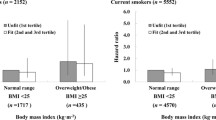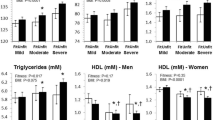Abstract
This study examines the relative importance of fitness versus fatness in predicting mortality in elderly populations aged 70 years and over, and whether fitness may account for the ‘paradoxical’ relationship between better survival and increasing weight. Four thousand community-living Chinese men and women aged 65 years or over were recruited and stratified so that approximately 33% were in each of the age groups: 65–69, 70–74, and 75 or above. Medical history, height, weight, waist–hip ratio, body composition using DEXA, and walking speed were obtained. They were followed up for a mean of 7.0 years to ascertain death. Compared with the high fitness category, those in the moderate and low categories have a 43% and 68% increased risk of mortality at 7 years adjusting for multiple confounders. When mortality risk according to various fatness indicators was examined, only the lowest quartile of BMI, BFI, and FLMR conferred statistically significant increased risk. Fitness categories were significantly associated with all fatness indicators. The finding of fewer people in the high fitness category among the highest quartiles of other fatness indicators suggests that fitness is not the underlying mechanism for the obesity paradox. Within each quartile of fatness indicator, there was a significant trend towards reduced mortality with increasing fitness. In conclusion, the study confirms the beneficial effects of cardiorespiratory fitness on mortality but does not explain the ‘obesity paradox’. The findings underscore the importance of maintaining physical fitness through exercise and re-confirm the importance of weight maintenance in reducing mortality risk.
Similar content being viewed by others
References
Auyeung TW, Lee JS, Leung J, Kwok T, Leung PC, Woo J (2010) Survival in older men may benefit from being slightly overweight and centrally obese—a 5-year follow-up study in 4,000 older adults using DXA. J Gerontol A Biol Sci Med Sci 65(1):99–104
Bertin E, Marcus C, Ruiz JC, Eschard JP, Leutenegger M (2000) Measurement of visceral adipose tissue by DXA combined with anthropometry in obese humans. Int J Obes Relat Metab Disord 24(3):263–270
Cooper KH (1968) A means of assessing maximal oxygen intake. Correlation between field and treadmill testing. JAMA 203(3):201–204
Cruz-Jentoft AJ, Baeyens JP, Bauer JM, Boirie Y, Cederholm T, Landi F et al (2010) Sarcopenia: European consensus on definition and diagnosis: report of the European Working Group on sarcopenia in older people. Age Ageing 39(4):412–423
Dumurgier J, Elbaz A, Ducimetiere P, Tavernier B, Alperovitch A, Tzourio C (2009) Slow walking speed and cardiovascular death in well functioning older adults: prospective cohort study. BMJ 339:b4460
Flicker L, McCaul KA, Hankey GJ, Jamrozik K, Brown WJ, Byles JE et al (2010) Body mass index and survival in men and women aged 70 to 75. J Am Geriatr Soc 58(2):234–241
Fogelholm M (2010) Physical activity, fitness and fatness: relations to mortality, morbidity and disease risk factors. A systematic review. Obes Rev 11(3):202–221
Fried LP, Tangen CM, Walston J, Newman AB, Hirsch C, Gottdiener J et al (2001) Frailty in older adults: evidence for a phenotype. J Gerontol A Biol Sci Med Sci 56(3):M146–M156
Harwood RH, Conroy SP (2009) Slow walking speed in elderly people. BMJ 339:b4236
Lee CG, Boyko EJ, Nielson CM, Stefanick ML, Bauer DC, Hoffman AR et al (2011a) Mortality risk in older men associated with changes in weight, lean mass, and fat mass. J Am Geriatr Soc 59(2):233–240
Lee JS, Auyeung TW, Kwok T, Li M, Leung J, Woo J (2011b. DOI 10.1007/s11357-011-9272-y). Survival benefit of abdominal adiposity: a 6-year follow-up study with Dual X-ray absorptiometry in 3,978 older adults. Age (Dordr)
McAuley P, Pittsley J, Myers J, Abella J, Froelicher VF (2009) Fitness and fatness as mortality predictors in healthy older men: the veterans exercise testing study. J Gerontol A Biol Sci Med Sci 64(6):695–699
McAuley PA, Kokkinos PF, Oliveira RB, Emerson BT, Myers JN (2010a) Obesity paradox and cardiorespiratory fitness in 12,417 male veterans aged 40 to 70 years. Mayo Clin Proc 85(2):115–121
McAuley PA, Sui X, Blair SN (2010b) Letter by McAuley et al regarding article, "Impact of body mass index and the metabolic syndrome on the risk of cardiovascular disease and death in middle-aged men". Circulation 122(11):e455, author reply e457
Morley JE (2007) Weight loss in older persons: new therapeutic approaches. Curr Pharm Des 13(35):3637–3647
Rolland YM, Cesari M, Miller ME, Penninx BW, Atkinson HH, Pahor M (2004) Reliability of the 400-m usual-pace walk test as an assessment of mobility limitation in older adults. J Am Geriatr Soc 52(6):972–976
Simonsick EM, Gardner AW, Poehlman ET (2000) Assessment of physical function and exercise tolerance in older adults: reproducibility and comparability of five measures. Aging (Milano) 12(4):274–280
Simonsick EM, Montgomery PS, Newman AB, Bauer DC, Harris T (2001) Measuring fitness in healthy older adults: the Health ABC Long Distance Corridor Walk. J Am Geriatr Soc 49(11):1544–1548
Stessman J, Jacobs JM, Ein-Mor E, Bursztyn M (2009) Normal body mass index rather than obesity predicts greater mortality in elderly people: the Jerusalem longitudinal study. J Am Geriatr Soc 57(12):2232–2238
Sui X, LaMonte MJ, Laditka JN, Hardin JW, Chase N, Hooker SP et al (2007) Cardiorespiratory fitness and adiposity as mortality predictors in older adults. JAMA 298(21):2507–2516
Troosters T, Gosselink R, Decramer M (1999) Six minute walking distance in healthy elderly subjects. Eur Respir J 14(2):270–274
Washburn RA, Smith KW, Jette AM, Janney CA (1993) The Physical Activity Scale for the Elderly (PASE): development and evaluation. J Clin Epidemiol 46(2):153–162
Woo J, Ho SC, Sham A (2001) Longitudinal changes in body mass index and body composition over 3 years and relationship to health outcomes in Hong Kong Chinese age 70 and older. J Am Geriatr Soc 49(6):737–746
Woo J, Ho SC, Yu AL, Sham A (2002) Is waist circumference a useful measure in predicting health outcomes in the elderly? Int J Obes Relat Metab Disord 26(10):1349–1355
Yau CFF (2011) Cardiorespiratory fitness of Hong Kong Chinese elderly and its relationship between physical activity participation and health. The Chinese University of Hong Kong, Shatin
Acknowledgements
This study is supported by the SH Ho Centre for Gerontology and Geriatrics, the Centre for Nutritional Studies, Faculty of Medicine, The Chinese University of Hong Kong, and the Hong Kong Jockey Club Charities Trust.
Author information
Authors and Affiliations
Corresponding author
About this article
Cite this article
Woo, J., Yu, R. & Yau, F. Fitness, fatness and survival in elderly populations. AGE 35, 973–984 (2013). https://doi.org/10.1007/s11357-012-9398-6
Received:
Accepted:
Published:
Issue Date:
DOI: https://doi.org/10.1007/s11357-012-9398-6




